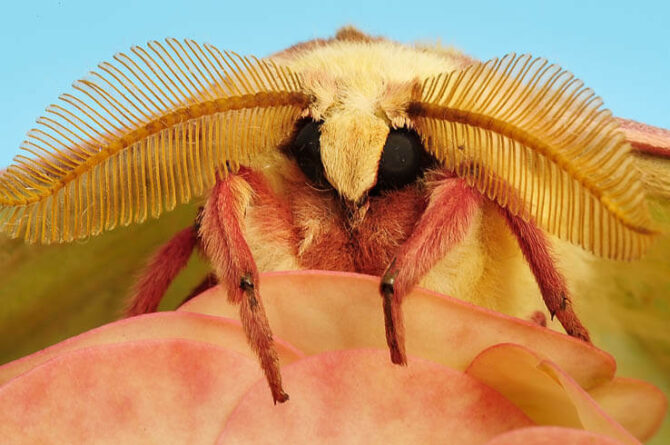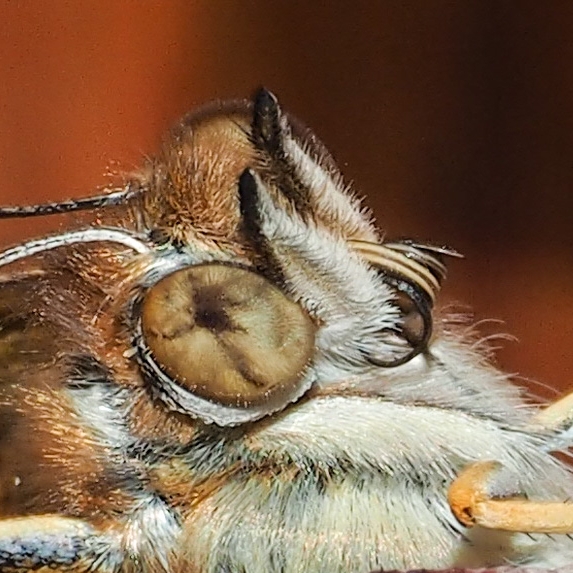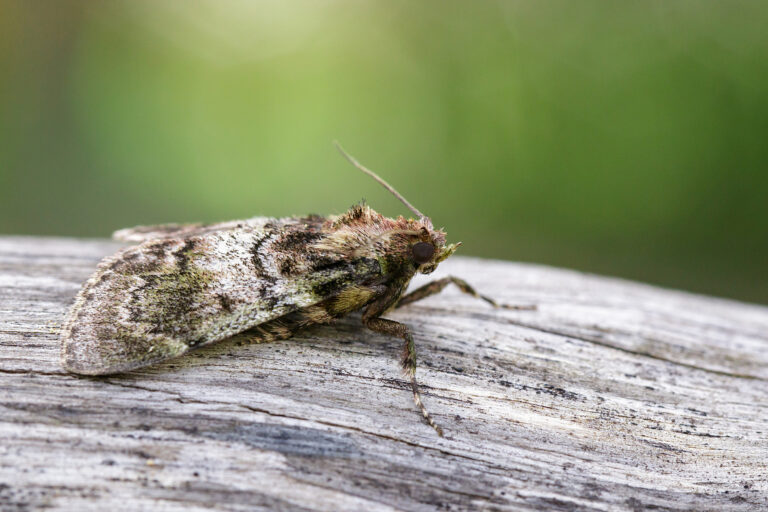No, moths do not eat wood. Moths are primarily herbivorous insects, and their diet consists of nectar, pollen, and other plant materials. Some moths may also feed on fruits or sap, but they do not consume wood.
Wood-eating insects are typically different from moths and include organisms like termites and certain types of beetles. Termites, for example, are well-known for their ability to digest cellulose found in wood, while wood-boring beetles can tunnel into and feed on wood.
Moreover, these insects are responsible for the decomposition and deterioration of wooden structures and can cause damage to homes and trees. Moths, on the other hand, are not known for causing damage to wood.
What Do Moths Eat?
Moths are primarily herbivorous insects, which means they predominantly feed on plant-based materials. In addition, this herbivorous nature is a common characteristic shared by many moth species around the world.
Primary Food Sources
Nectar: Nectar is one of the primary food sources for adult moths. Moths have specialized mouthparts, known as proboscises, which they use to access the nectar from flowers.
By feeding on nectar, moths play an essential role in pollination, as they transfer pollen from one flower to another, aiding in the reproduction of plants.
Pollen: While moths primarily feed on nectar, some species may inadvertently consume pollen while feeding on flowers.
Pollen contains essential nutrients and proteins that can supplement their diet.
Plant Materials: Besides nectar and pollen, moths may consume other parts of plants, such as leaves or stems.
Some moth caterpillars are known to be folivorous, meaning they feed on leaves, which can be specific to certain plant species.
In this stage of their lifecycle, caterpillars play a crucial role in nutrient cycling within ecosystems.
Rare Instances of Moths Consuming Other Substances

Fruits: While fruits are not a typical part of a moth’s diet, there are instances where moths might feed on overripe or damaged fruits.
In such cases, moths are attracted to the sugars and fermenting juices released by the fruit.
Moths can also inadvertently feed on fruit juices while sipping nectar from nearby flowers.
Sap: Some moth species may occasionally feed on sap, especially if they have access to tree wounds or other sources of sap flow.
Moreover, sap contains sugars and nutrients that can serve as an alternative food source for moths in certain situations.
How Do Wood-Eating Insects Damage Structures?
Wood-eating insects can cause substantial damage to wooden structures and trees, making them a significant concern for homeowners, foresters, and conservationists.
Explanation of Wood-Eating Insects
Termites: Termites are social insects belonging to the order Isoptera, and they are well-known for their ability to digest cellulose, a complex carbohydrate found in wood and plant materials.
Moreover, termites live in colonies and are divided into different castes, including workers, soldiers, and reproductive individuals.
Worker termites are responsible for foraging for wood and plant material, which they bring back to the colony to feed the entire colony.
The digestive system of termites contains symbiotic microorganisms (protozoa and bacteria) that help break down cellulose, allowing termites to extract nutrients from wood.
Wood-Boring Beetles: Wood-boring beetles are a diverse group of insects belonging to various families, such as the Cerambycidae (longhorn beetles) and Buprestidae (jewel beetles).
Furthermore, these insects are characterized by their ability to tunnel into wood, where they lay their eggs and develop as larvae.
The larvae of wood-boring beetles are the primary wood-feeders, and they have specialized mouthparts for chewing and digesting wood fibers.
As the larvae grow, they create intricate galleries or tunnels within the wood, which can weaken the structure and cause damage.
How Wood-Eating Insects Differ from Moths?
Wood-eating insects, such as termites and wood-boring beetles, differ from moths in several key ways:
Diet: The most significant distinction is their diet. Wood-eating insects primarily consume wood and plant material, specifically targeting the cellulose component.
Moths, on the other hand, are primarily herbivorous, feeding on nectar, pollen, and various plant materials. They do not have the physiological adaptations to digest wood.
Mouthparts: Wood-eating insects have specialized mouthparts adapted for chewing and breaking down wood fibers. Termites have symbiotic microorganisms that assist in cellulose digestion.
Moths have proboscises (elongated mouthparts) designed for sipping nectar from flowers and do not possess the chewing capabilities necessary for wood consumption.
Habitat: Wood-eating insects, particularly termites, live within or near their food source (wood), and they often build extensive tunnel systems.
In addition, moths typically inhabit a variety of ecosystems, such as forests, gardens, and grasslands, where they can access their primary food sources, nectar-producing flowers.
The Damage Caused by Wood-Eating Insects
Wood-eating insects can cause significant damage to wooden structures, trees, and furniture. The extent of damage depends on factors like the type of insect, the size of the colony or infestation, and the duration of infestation.
Damage includes
- Structural Weakness: Wood-eating insects can weaken wooden structures, compromising their integrity and safety.
- Economic Costs: Infestations in homes and commercial buildings can lead to costly repairs and treatments.
- Tree Health: Infestations in trees can affect their growth, stability, and overall health.
- Damage to Furniture: Wood-boring beetles can damage wooden furniture, antiques, and artifacts.
How Do Moths Contribute to Ecosystems?

Wood-eating insects, such as termites and wood-boring beetles, have evolved to feed on wood and serve as important decomposers in forest ecosystems.
Clarification that Moths Do Not Eat Wood
- It is essential to emphasize that moths do not eat wood. Moths are herbivorous insects with a diet primarily focused on nectar, pollen, and various plant materials.
- Unlike wood-eating insects like termites and wood-boring beetles, moths lack the physiological adaptations necessary to digest and extract nutrients from cellulose, the main component of wood.
- Moths have specialized mouthparts called proboscises, designed for sipping liquid substances like nectar and pollen from flowers. These mouthparts are not equipped for chewing or breaking down wood fibers.
- Moths’ digestive systems are adapted to process sugars and other compounds found in plant-based foods, not the complex carbohydrates found in wood.
Moths’ Role in Ecosystems
Moths play several important roles in ecosystems, even though they do not consume wood:
- Pollination: Moths are vital pollinators for a wide variety of plant species, especially those with night-blooming flowers. As they feed on nectar from these flowers, they inadvertently transfer pollen from one bloom to another, facilitating plant reproduction.
- Food Source: Moth caterpillars serve as a food source for numerous other organisms, including birds, bats, and insects. They are an integral part of the food web.
- Decomposition: Moth caterpillars, which feed on plant leaves, contribute to the decomposition process in ecosystems. Their waste products and discarded plant matter can become part of the nutrient cycle.
Moths’ nocturnal activities also contribute to the pollination of plants that rely on nighttime pollinators, filling a unique ecological niche.
Examples of Insects That Do Eat Wood
While moths do not consume wood, there are specific insects and arthropods that have adapted to feed on wood and play a significant role in wood decomposition and ecosystem processes:
- Termites: Termites are well-known wood-eating insects, and they are among the most efficient decomposers of cellulose in the natural world.
- Wood-Boring Beetles: Various beetle species, such as longhorn beetles, jewel beetles, and powderpost beetles, bore into and consume wood as both larvae and adults.
- Carpenter Ants: While they don’t eat wood, carpenter ants excavate galleries within wood for nesting purposes, which can weaken wooden structures.
These wood-eating insects have evolved specialized adaptations to thrive on wood, and their activities are critical for breaking down dead plant material and returning nutrients to the ecosystem.
FAQ’s
Is moth dust harmful?
Moth dust, often found on moth wings, is not harmful to humans. It’s primarily made up of scales that help moths fly and protect them from predators.
What wood keeps moths away?
Cedarwood is known to repel moths due to its natural aromatic oils. Cedarwood closets and hangers are commonly used for moth prevention.
What wood is good for moths?
Moths do not eat or prefer any specific type of wood. They primarily feed on nectar, pollen, and plant materials, not wood.
Is it OK to sleep with a moth in your room?
Yes, it is generally safe to sleep with a moth in your room. Moths are harmless to humans and do not pose any health risks.
Is a moth in your room bad?
Having a moth in your room is not inherently bad. Moths are usually harmless and can be safely released or guided out of the room if desired.
Can you touch a moth?
Yes, you can touch a moth, but it’s advisable to handle them gently to avoid damaging their delicate wings or scales.
Final Words
In conclusion, moths are not wood-eaters; they prefer nectar, pollen, and plant materials. Their unique role lies in pollination, helping plants grow and reproduce. Unlike moths, wood-eating insects like termites and wood-boring beetles munch on wood.
Furthermore, this can weaken structures, cost money to fix, and even harm trees. So, remember, when it comes to eating wood, moths are a no-go, but other insects are quite the opposite!

